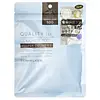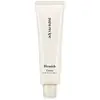What's inside
What's inside
 Key Ingredients
Key Ingredients

 Benefits
Benefits

 Concerns
Concerns

 Ingredients Side-by-side
Ingredients Side-by-side

Water
Skin ConditioningDipropylene Glycol
HumectantGlycerin
HumectantCerebrosides
EmollientNiacinamide
SmoothingAscorbic Acid
AntioxidantTrisodium Ascorbyl Palmitate Phosphate
AntioxidantMagnesium Ascorbyl Phosphate
AntioxidantAscorbyl Tetraisopalmitate
AntioxidantDipotassium Glycyrrhizate
HumectantButylene Glycol
HumectantTripropylene Glycol
AntioxidantHydrogenated Lecithin
EmulsifyingGlycine Soja Sterols
EmollientCeramide NP
Skin ConditioningCeramide AP
Skin ConditioningCeramide EOP
Skin ConditioningPhellodendron Amurense Bark Extract
Skin ConditioningPEG-60 Hydrogenated Castor Oil
EmulsifyingXanthan Gum
EmulsifyingEthylhexylglycerin
Skin ConditioningPotassium Hydroxide
BufferingCitric Acid
BufferingSodium Citrate
BufferingEtidronic Acid
Lavandula Angustifolia Oil
MaskingCitrus Limon Peel Oil
MaskingCitrus Aurantifolia Oil
CleansingLemongrass Oil
Juniperus Mexicana Oil
MaskingRosmarinus Officinalis Leaf Oil
MaskingPhytosphingosine
Skin ConditioningCholesterol
EmollientSodium Lauroyl Lactylate
EmulsifyingCarbomer
Emulsion StabilisingWater, Dipropylene Glycol, Glycerin, Cerebrosides, Niacinamide, Ascorbic Acid, Trisodium Ascorbyl Palmitate Phosphate, Magnesium Ascorbyl Phosphate, Ascorbyl Tetraisopalmitate, Dipotassium Glycyrrhizate, Butylene Glycol, Tripropylene Glycol, Hydrogenated Lecithin, Glycine Soja Sterols, Ceramide NP, Ceramide AP, Ceramide EOP, Phellodendron Amurense Bark Extract, PEG-60 Hydrogenated Castor Oil, Xanthan Gum, Ethylhexylglycerin, Potassium Hydroxide, Citric Acid, Sodium Citrate, Etidronic Acid, Lavandula Angustifolia Oil, Citrus Limon Peel Oil, Citrus Aurantifolia Oil, Lemongrass Oil, Juniperus Mexicana Oil, Rosmarinus Officinalis Leaf Oil, Phytosphingosine, Cholesterol, Sodium Lauroyl Lactylate, Carbomer
Galactomyces Ferment Filtrate
HumectantDipropylene Glycol
HumectantCaprylic/Capric Triglyceride
MaskingGlycerin
HumectantPanthenol
Skin ConditioningHydrogenated Polydecene
EmollientHydrogenated Polyisobutene
Emollient1,2-Hexanediol
Skin ConditioningButylene Glycol
HumectantNiacinamide
SmoothingCyclopentasiloxane
EmollientCyclohexasiloxane
EmollientC12-16 Alcohols
EmollientDimethicone
EmollientHydrogenated Lecithin
EmulsifyingDimethicone/Vinyl Dimethicone Crosspolymer
Skin ConditioningPalmitic Acid
EmollientAcrylates/C10-30 Alkyl Acrylate Crosspolymer
Emulsion StabilisingWater
Skin ConditioningTromethamine
BufferingGlyceryl Stearate
EmollientCetearyl Olivate
C14-22 Alcohols
Emulsion StabilisingStearic Acid
CleansingSorbitan Olivate
EmulsifyingDimethiconol
EmollientC12-20 Alkyl Glucoside
EmulsifyingAdenosine
Skin ConditioningC12-14 Sec-Pareth-7
EmulsifyingDisodium EDTA
Myristic Acid
CleansingEthylhexylglycerin
Skin ConditioningXanthan Gum
EmulsifyingGlucose
HumectantCamellia Japonica Seed Oil
EmollientCeramide NP
Skin ConditioningPropylene Glycol
HumectantSaccharomyces/Xylinum/Black Tea Ferment
Skin ConditioningLinoleic Acid
CleansingLactobacillus/Soybean Ferment Extract
Skin ConditioningLactobacillus/Acerola Cherry Ferment
Skin ProtectingLactobacillus/Punica Granatum Fruit Ferment Extract
Skin ConditioningLactobacillus/Wasabia Japonica Root Ferment Extract
AntioxidantLactobacillus/Hibiscus Sabdariffa Flower Ferment Filtrate
Skin ConditioningSh-Oligopeptide-1
Skin ConditioningGalactomyces Ferment Filtrate, Dipropylene Glycol, Caprylic/Capric Triglyceride, Glycerin, Panthenol, Hydrogenated Polydecene, Hydrogenated Polyisobutene, 1,2-Hexanediol, Butylene Glycol, Niacinamide, Cyclopentasiloxane, Cyclohexasiloxane, C12-16 Alcohols, Dimethicone, Hydrogenated Lecithin, Dimethicone/Vinyl Dimethicone Crosspolymer, Palmitic Acid, Acrylates/C10-30 Alkyl Acrylate Crosspolymer, Water, Tromethamine, Glyceryl Stearate, Cetearyl Olivate, C14-22 Alcohols, Stearic Acid, Sorbitan Olivate, Dimethiconol, C12-20 Alkyl Glucoside, Adenosine, C12-14 Sec-Pareth-7, Disodium EDTA, Myristic Acid, Ethylhexylglycerin, Xanthan Gum, Glucose, Camellia Japonica Seed Oil, Ceramide NP, Propylene Glycol, Saccharomyces/Xylinum/Black Tea Ferment, Linoleic Acid, Lactobacillus/Soybean Ferment Extract, Lactobacillus/Acerola Cherry Ferment, Lactobacillus/Punica Granatum Fruit Ferment Extract, Lactobacillus/Wasabia Japonica Root Ferment Extract, Lactobacillus/Hibiscus Sabdariffa Flower Ferment Filtrate, Sh-Oligopeptide-1
 Reviews
Reviews

Ingredients Explained
These ingredients are found in both products.
Ingredients higher up in an ingredient list are typically present in a larger amount.
Butylene Glycol (or BG) is used within cosmetic products for a few different reasons:
Overall, Butylene Glycol is a safe and well-rounded ingredient that works well with other ingredients.
Though this ingredient works well with most skin types, some people with sensitive skin may experience a reaction such as allergic rashes, closed comedones, or itchiness.
Learn more about Butylene GlycolCeramide NP is a type of ceramide and formally known as ceramide 3.
Ceramides are intercellular lipids naturally found in our skin that bonds dead skin cells together to create a barrier. They are known for their ability to hold water and thus are a great ingredient for dry skin.
Ceramides are an important building block for our skin barrier. A stronger barrier helps the skin look more firm and hydrated. By bolstering the skin ceramides act as a barrier against irritating ingredients. This can help with inflammation as well.
If you would like to eat ceramides, sweet potatoes contain a small amount.
Read more about other common types of ceramides here:
Ceramide AP
Ceramide EOP
Dipropylene Glycol is a synthetically created humectant, stabilizer, and solvent.
This ingredient helps:
Dipropylene glycol is technically an alcohol, but it belongs to the glycol family (often considered part of the ‘good’ alcohols). This means it is hydrating and gentle on skin unlike drying solvent alcohols like denatured alcohol.
As a masking agent, Dipropylene Glycol can be used to cover the smell of other ingredients. However, it does not have a scent.
Studies show Dipropylene Glycol is considered safe to use in skincare.
Learn more about Dipropylene GlycolEthylhexylglycerin (we can't pronounce this either) is commonly used as a preservative and skin softener. It is derived from glyceryl.
You might see Ethylhexylglycerin often paired with other preservatives such as phenoxyethanol. Ethylhexylglycerin has been found to increase the effectiveness of these other preservatives.
Glycerin is already naturally found in your skin. It helps moisturize and protect your skin.
A study from 2016 found glycerin to be more effective as a humectant than AHAs and hyaluronic acid.
As a humectant, it helps the skin stay hydrated by pulling moisture to your skin. The low molecular weight of glycerin allows it to pull moisture into the deeper layers of your skin.
Hydrated skin improves your skin barrier; Your skin barrier helps protect against irritants and bacteria.
Glycerin has also been found to have antimicrobial and antiviral properties. Due to these properties, glycerin is often used in wound and burn treatments.
In cosmetics, glycerin is usually derived from plants such as soybean or palm. However, it can also be sourced from animals, such as tallow or animal fat.
This ingredient is organic, colorless, odorless, and non-toxic.
Glycerin is the name for this ingredient in American English. British English uses Glycerol/Glycerine.
Learn more about GlycerinHydrogenated Lecithin is created from the hydrogenation of lecithin (a group of phospholipids). Hydrogenation is a chemical reaction between hydrogen and another element.
This ingredient is an emollient and emulsifier. As an emollient, it helps soften skin by trapping moisture within. As an emulsifier, it prevents oil and water ingredients from separating.
Niacinamide is a multitasking form of vitamin B3 that strengthens the skin barrier, reduces pores and dark spots, regulates oil, and improves signs of aging.
And the best part? It's gentle and well-tolerated by most skin types, including sensitive and reactive skin.
You might have heard of "niacin flush", or the reddening of skin that causes itchiness. Niacinamide has not been found to cause this.
In very rare cases, some individuals may not be able to tolerate niacinamide at all or experience an allergic reaction to it.
If you are experiencing flaking, irritation, and dryness with this ingredient, be sure to double check all your products as this ingredient can be found in all categories of skincare.
When incorporating niacinamide into your routine, look out for concentration amounts. Typically, 5% niacinamide provides benefits such as fading dark spots. However, if you have sensitive skin, it is better to begin with a smaller concentration.
When you apply niacinamide to your skin, your body converts it into nicotinamide adenine dinucleotide (NAD). NAD is an essential coenzyme that is already found in your cells as "fuel" and powers countless biological processes.
In your skin, NAD helps repair cell damage, produce new healthy cells, support collagen production, strengthen the skin barrier, and fight environmental stressors (like UV and pollution).
Our natural NAD levels start to decline with age, leading to slower skin repair, visible aging, and a weaker skin barrier. By providing your skin niacinamide, you're recharging your skin's NAD levels. This leads to stronger, healthier, and younger looking skin.
Another name for vitamin B3 is nicotinamide. This vitamin is water-soluble and our bodies don't store it. We obtain Vitamin B3 from either food or skincare. Meat, fish, wheat, yeast, and leafy greens contain vitamin B3.
The type of niacinamide used in skincare is synthetically created.
Learn more about NiacinamideWater. It's the most common cosmetic ingredient of all. You'll usually see it at the top of ingredient lists, meaning that it makes up the largest part of the product.
So why is it so popular? Water most often acts as a solvent - this means that it helps dissolve other ingredients into the formulation.
You'll also recognize water as that liquid we all need to stay alive. If you see this, drink a glass of water. Stay hydrated!
Learn more about WaterXanthan gum is used as a stabilizer and thickener within cosmetic products. It helps give products a sticky, thick feeling - preventing them from being too runny.
On the technical side of things, xanthan gum is a polysaccharide - a combination consisting of multiple sugar molecules bonded together.
Xanthan gum is a pretty common and great ingredient. It is a natural, non-toxic, non-irritating ingredient that is also commonly used in food products.
Learn more about Xanthan Gum